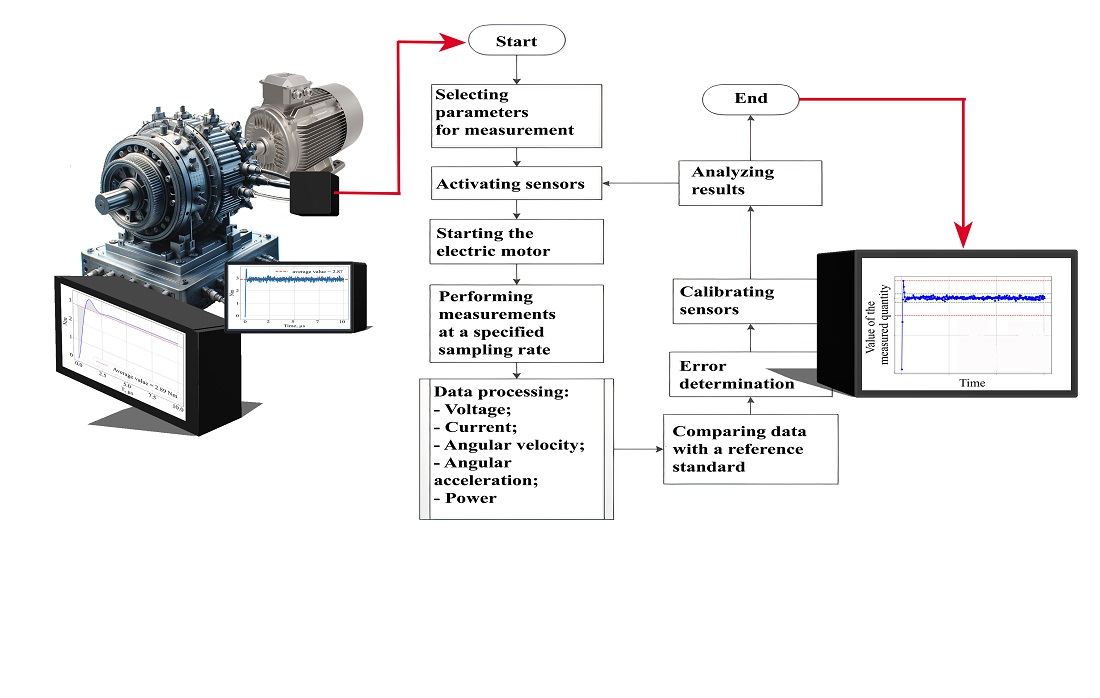Devising a technique for assessing the accuracy of measuring electric motor torque
DOI:
https://doi.org/10.15587/1729-4061.2024.302378Keywords:
torque, measurement accuracy, measurement error, measuring deviceAbstract
The object of this study is a technique for assessing the accuracy of measuring the torques of electric motors. This technique is based on the improvement of dynamic torque measurement processes under transient operating modes. Special attention was paid to devising adaptive methods to normalize the output signal, which take into account vibrations and nonlinearities of the measuring channel.
In order to improve the accuracy of measurements under conditions when the controlled parameter has different deviations from its average value, a technique for integrating time measurement intervals was proposed. That has made it possible to generalize parameter fluctuations, providing more stable measurement results.
This paper reports the simulation of the process of measuring torques of electric motors under transient operating modes and under vibration conditions. That has made it possible to test the proposed technique for estimating the variance of the methodological error, which includes the integration of measurement time intervals and makes it possible to increase the accuracy of the measurement under the conditions of transient modes in electric motor operation.
An algorithm for correcting the error of the dynamic torque of the electric motor has been proposed, which allows it to be corrected. This becomes possible owing to the use of a reference measure and the proposed technique for determining the deviations of the controlled parameter of the measured quantity, as well as the automatic calibration of measuring transducers.
The algorithm allows for flexible settings of the corrective action, expanding the potential of electric motor control systems. It can complement soft measurement methods, as well as adjust the threshold values of deviations under different operating modes of electric motors. This allows the measured systems to better adapt to changes in operating conditions, to adjust the specified measurement accuracy under conditions of uncertainty
References
- Kucheruk, V. Yu. (2003). Elementy teoriyi pobudovy system tekhnichnoho diahnostuvannia elektromotoriv. Vinnytsia, 195.
- Martyr, A. J., Plint, M. A. (2012). Dynamometers. Engine Testing, 227–258. https://doi.org/10.1016/b978-0-08-096949-7.00010-8
- Aarniovuori, L., Karkkainen, H., Niemela, M., Lindh, P., Pyrhonen, J. (2017). Induction motor torque estimation accuracy using motor terminal variables. 2017 IEEE International Electric Machines and Drives Conference (IEMDC). https://doi.org/10.1109/iemdc.2017.8002304
- Zhang, Y., Wernicke, L., Wulff, W., Bleicher, A., Schauer, T. (2023). Design and validation of a dual-functional damper based on a stepper motor for energy harvesting and vibration control. Mechanical Systems and Signal Processing, 200, 110568. https://doi.org/10.1016/j.ymssp.2023.110568
- Beller, S. (2022). Bir Fırçalı Redüktörlü Dc Motorda Yapay Zeka Yöntemleriyle Tork. Çukurova Üniversitesi Mühendislik Fakültesi Dergisi, 37 (4), 885–898. https://doi.org/10.21605/cukurovaumfd.1230790
- Szántó, A., Ádámkó, É., Juhász, G., Sziki, G. Á. (2022). Simultaneous measurement of the moment of inertia and braking torque of electric motors applying additional inertia. Measurement, 204, 112135. https://doi.org/10.1016/j.measurement.2022.112135
- Howard, M. (2013). The new generation of inductive sensors. World Pumps, 2013 (2), 10–11. https://doi.org/10.1016/s0262-1762(13)70055-5
- Karthika, M., Nisha, K. C. R. (2023). Arithmetic optimization algorithm based torque ripple minimization technique for solar fed sensorless BLDC drive for domestic applications. Optik, 290, 171286. https://doi.org/10.1016/j.ijleo.2023.171286
- Kvasnikov, V. P., Bratchenko, H. D., Kvashuk, D. M. (2023). Estimation of measuring uncertainty of electric motors torques using the theory of fuzzy sets. Collection of Scientific Works of the Odesa State Academy of Technical Regulation and Quality, 1 (22), 23–34. https://doi.org/10.32684/2412-5288-2023-1-22-23-34
- Kuhr, M. M. G. (2023). Identification of the dynamic force and moment characteristics of annular gaps using linear independent rotor whirling motions. Mechanical Systems and Signal Processing, 187, 109936. https://doi.org/10.1016/j.ymssp.2022.109936
- Wang, S., Wu, Y., Hou, L., Yang, Z. (2023). Predictive modeling for soft measurement of loader driveshaft torque based on large-scale distributed data. Measurement, 210, 112566. https://doi.org/10.1016/j.measurement.2023.112566

Downloads
Published
How to Cite
Issue
Section
License
Copyright (c) 2024 Volodymyr Kvasnikov, Dmytro Kvashuk, Mykhailo Prygara, Dmytro Siryy, Oleksii Shelukha

This work is licensed under a Creative Commons Attribution 4.0 International License.
The consolidation and conditions for the transfer of copyright (identification of authorship) is carried out in the License Agreement. In particular, the authors reserve the right to the authorship of their manuscript and transfer the first publication of this work to the journal under the terms of the Creative Commons CC BY license. At the same time, they have the right to conclude on their own additional agreements concerning the non-exclusive distribution of the work in the form in which it was published by this journal, but provided that the link to the first publication of the article in this journal is preserved.
A license agreement is a document in which the author warrants that he/she owns all copyright for the work (manuscript, article, etc.).
The authors, signing the License Agreement with TECHNOLOGY CENTER PC, have all rights to the further use of their work, provided that they link to our edition in which the work was published.
According to the terms of the License Agreement, the Publisher TECHNOLOGY CENTER PC does not take away your copyrights and receives permission from the authors to use and dissemination of the publication through the world's scientific resources (own electronic resources, scientometric databases, repositories, libraries, etc.).
In the absence of a signed License Agreement or in the absence of this agreement of identifiers allowing to identify the identity of the author, the editors have no right to work with the manuscript.
It is important to remember that there is another type of agreement between authors and publishers – when copyright is transferred from the authors to the publisher. In this case, the authors lose ownership of their work and may not use it in any way.









